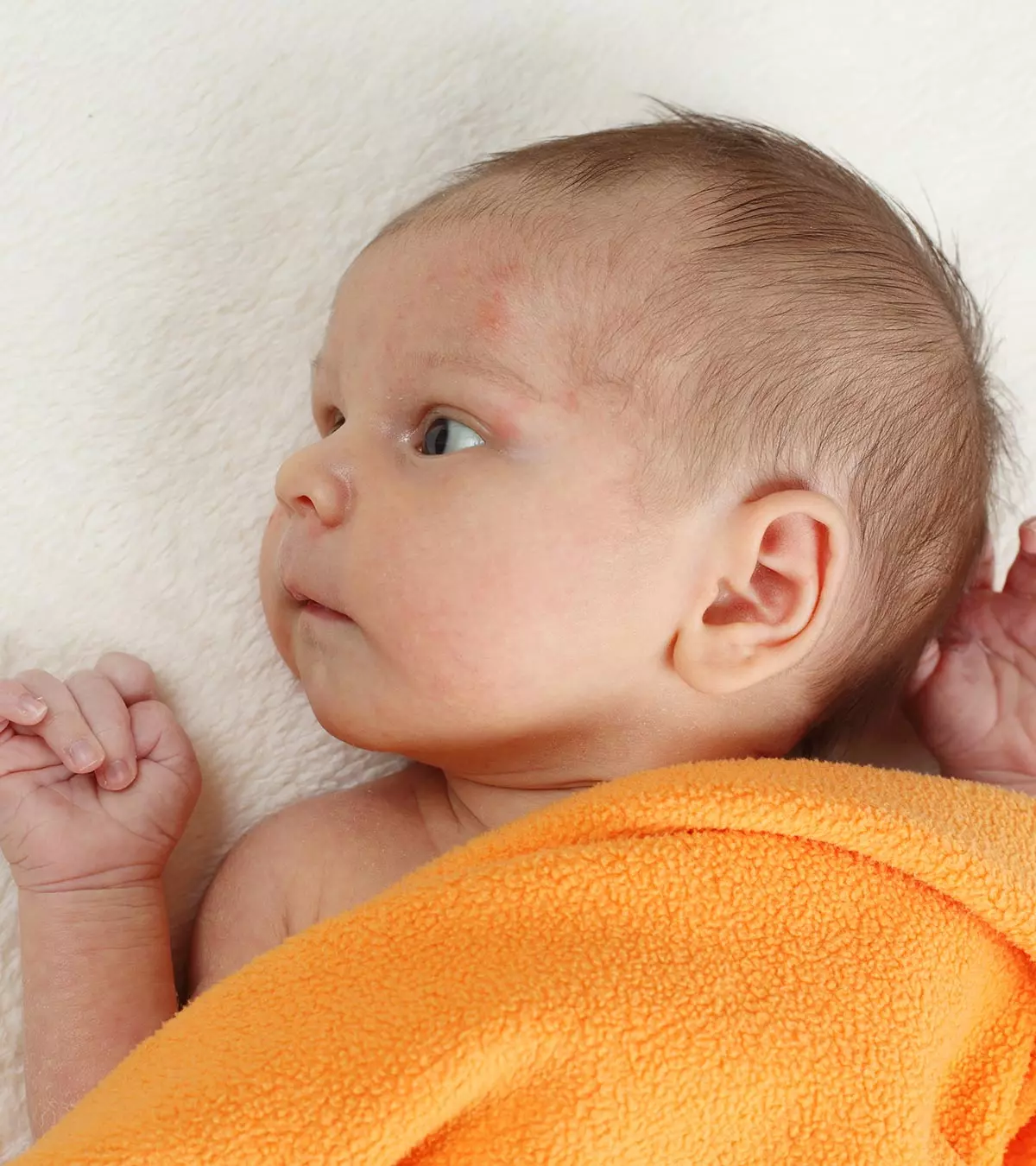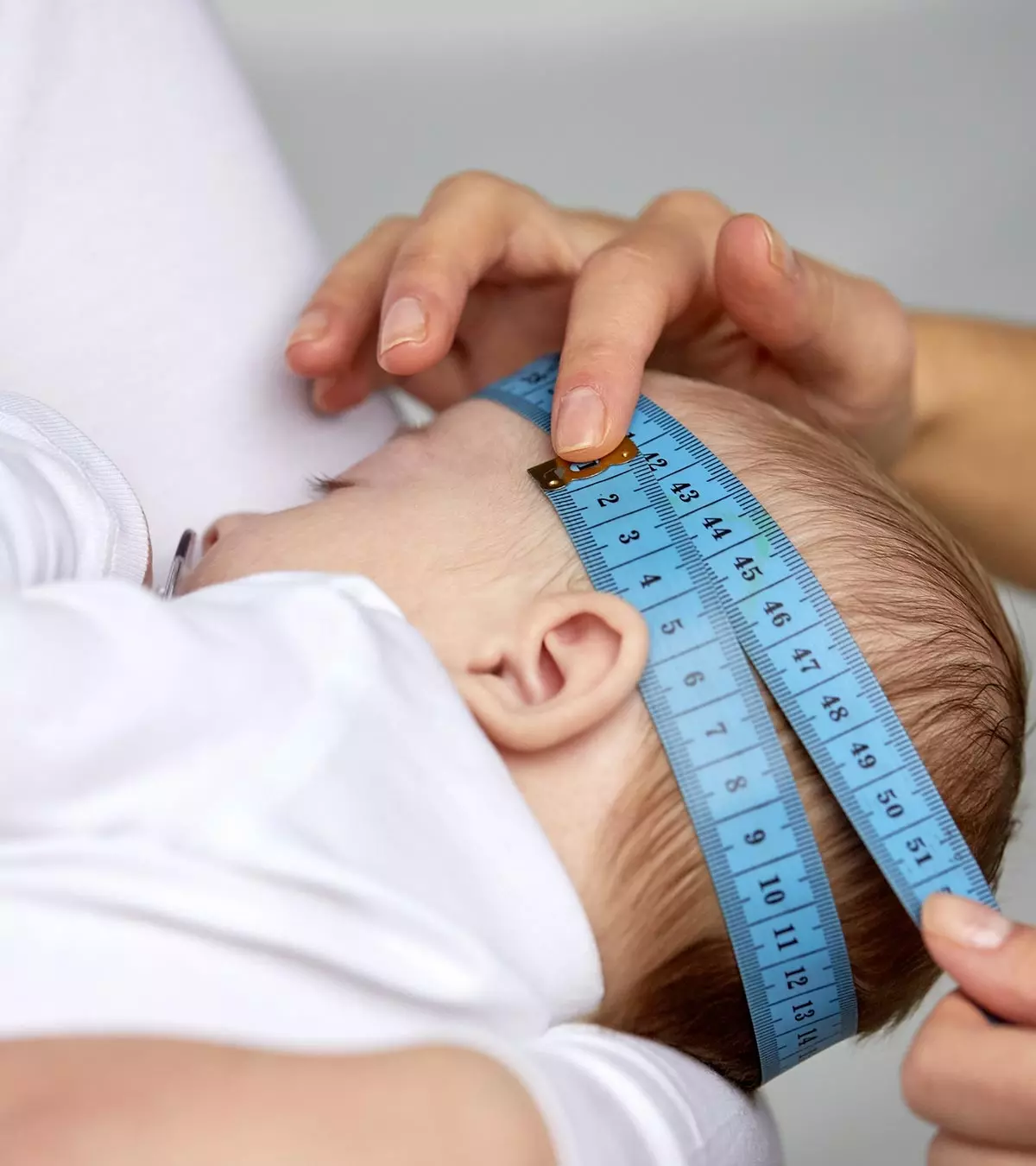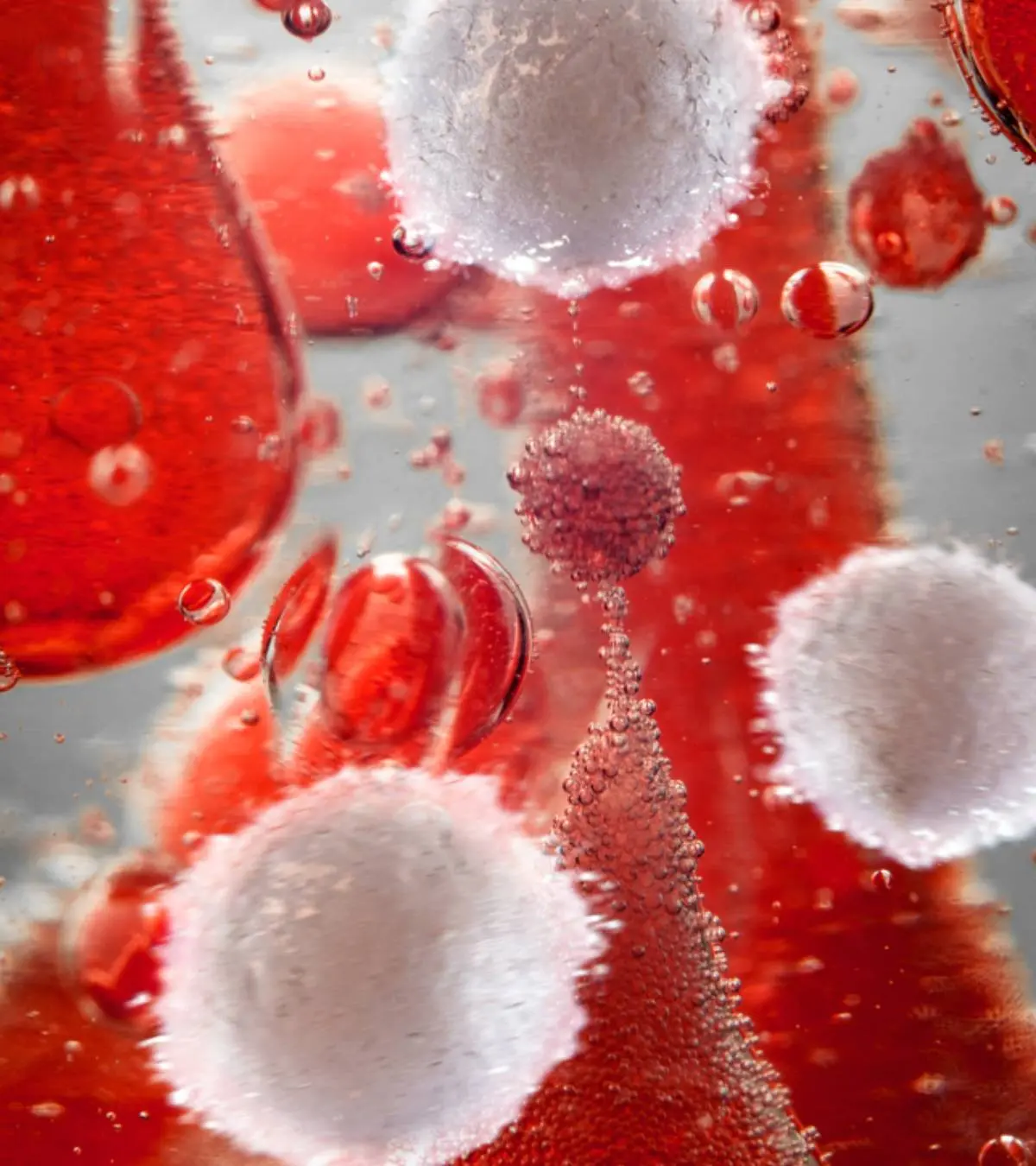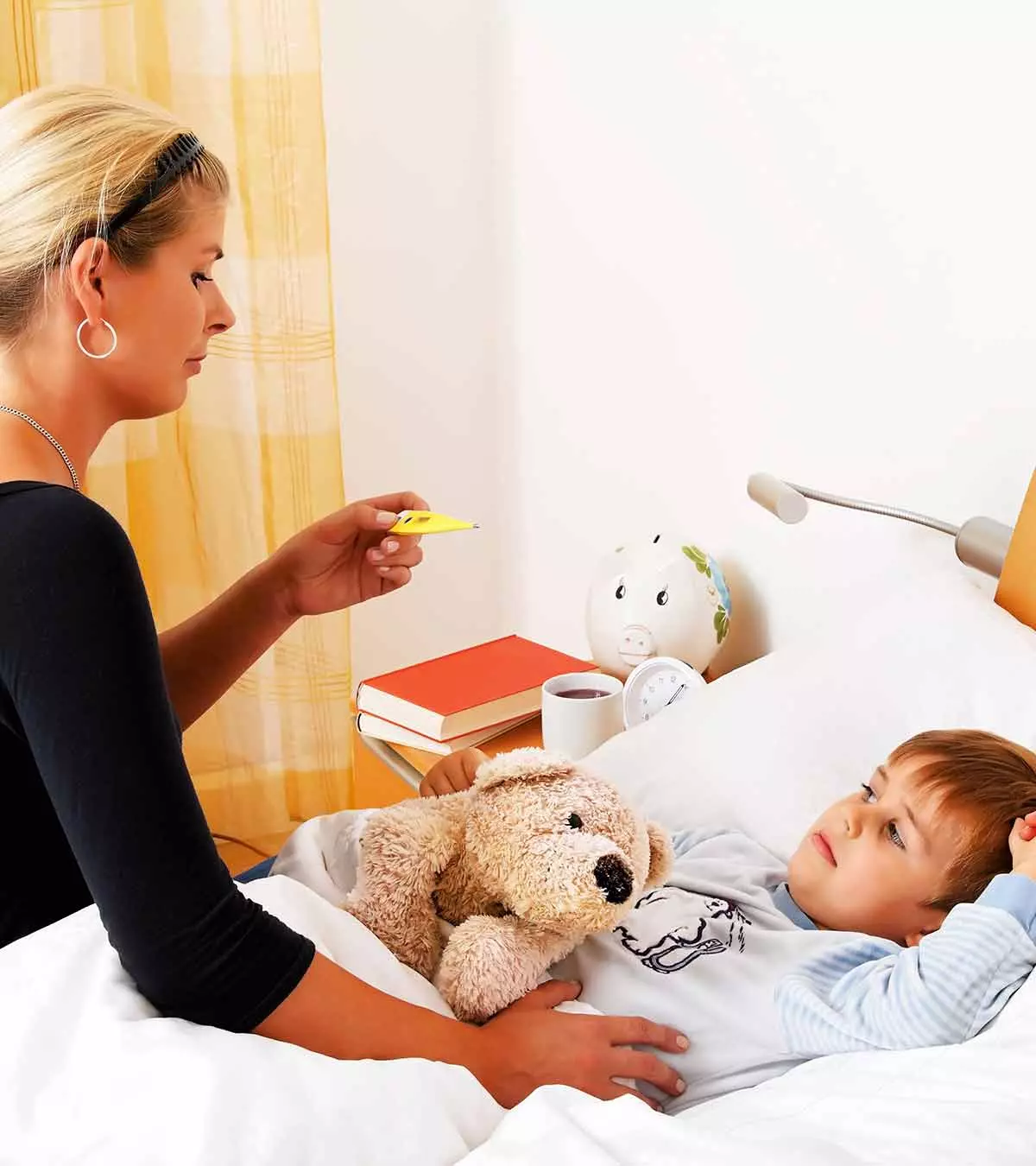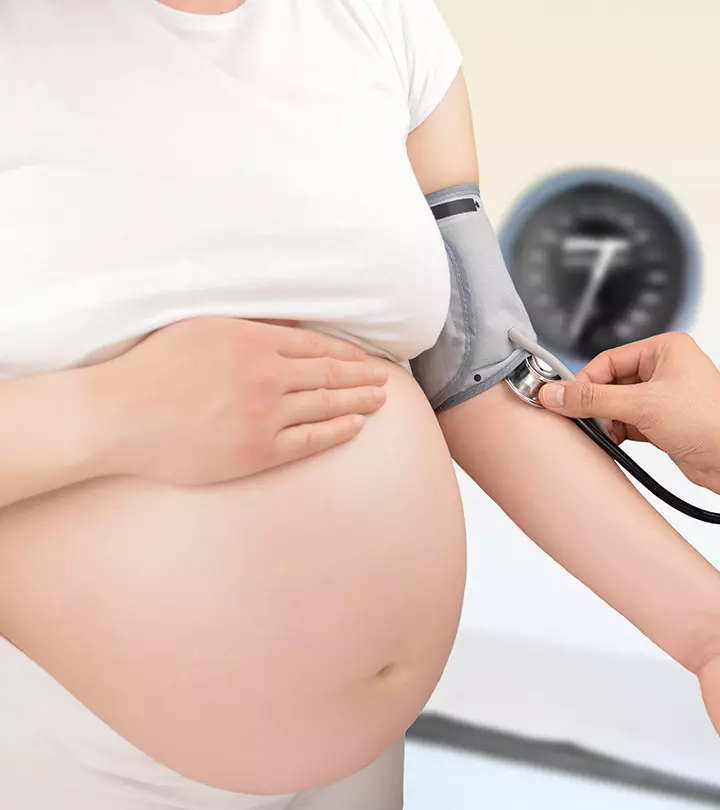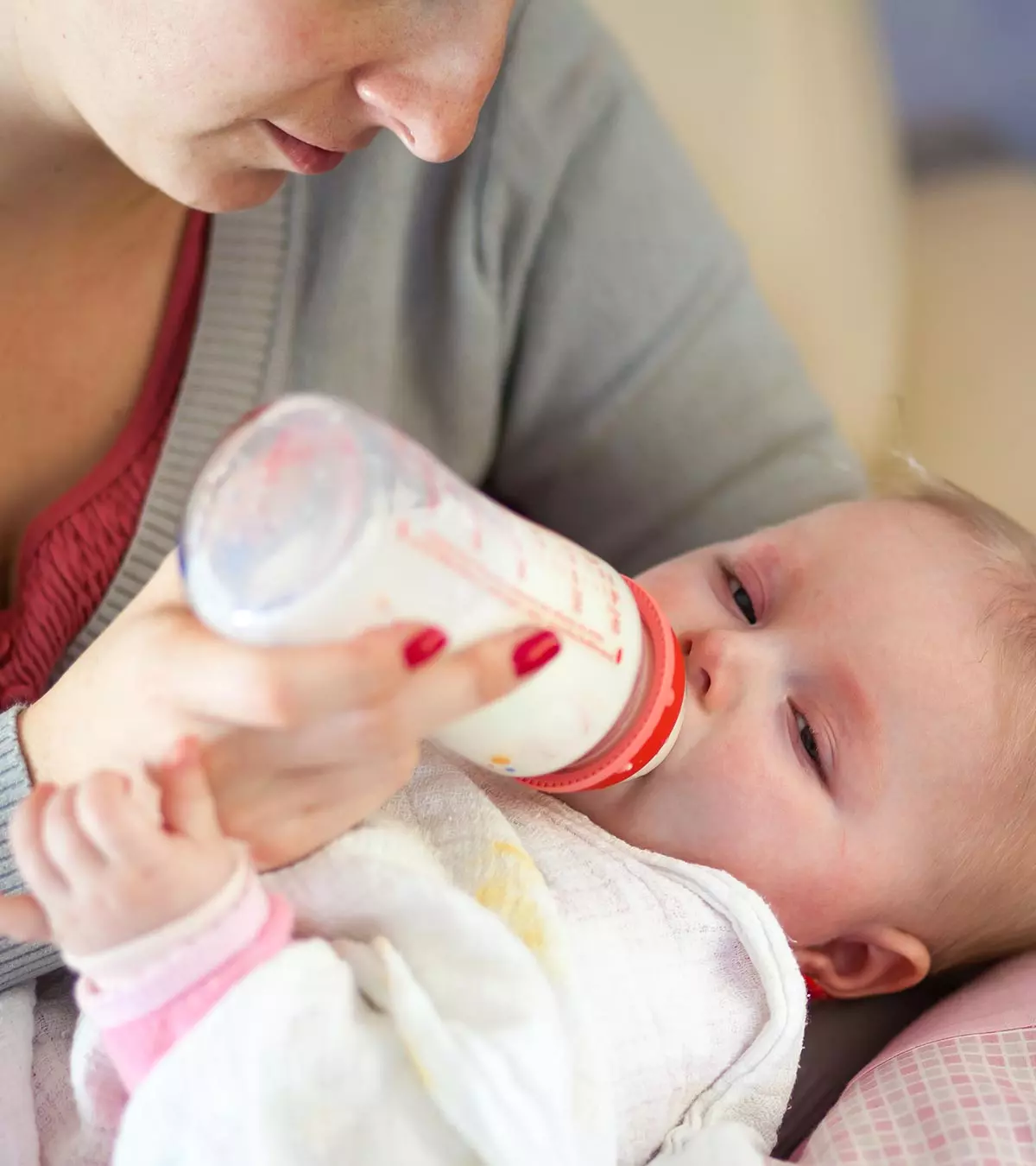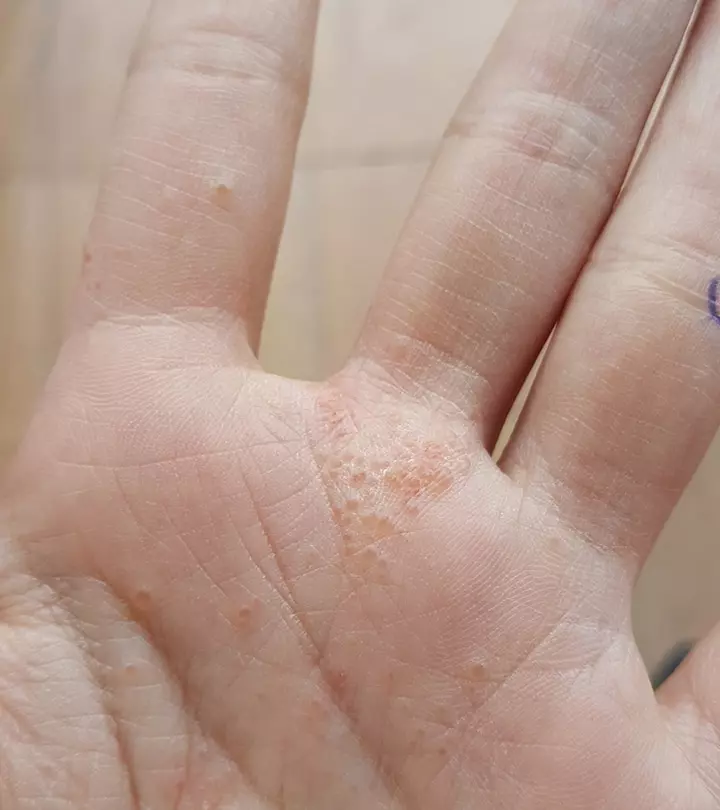
Image: Shutterstock
Like several other viral infections, it is possible to contract hand, foot, and mouth disease during pregnancy (HFMD), albeit rare. HFMD typically affects infants, children, the elderly, and those with a weakened immune system. It is caused by coxsackievirus, a type of enterovirusiA group of viruses that usually cause mild illness and spread through the oral or fecal route that is highly contagious.

A mother’s immunity is naturally suppressed during pregnancy to prevent fetal rejection; hence, it is possible to contract HFMD, especially in the later stages of gestation (1). Knowing the implications of HFMD during pregnancy is vital to protect maternal and fetal health.
Read on to learn about the symptoms, treatments, and prevention of HFMD during pregnancy.
Key Pointers
- Hand-foot-and-mouth disease in pregnancy manifests itself as a mild fever, sore throat, weariness, mouth and tongue ulcers, and skin lesions on the hands and soles.
- Hand, foot, and mouth disease is transferred via contaminated food or water, respiratory droplets, and direct contact with an infected individual.
- There is no specific cure, and the symptoms can be managed with fever medications, pain relievers, and drugs to reduce skin rashes and irritation.
Symptoms Of Hand, Foot, And Mouth Disease
Some pregnant women may have mild symptoms, while many are asymptomatic. The symptoms begin to appear after a few days of exposure to the virus. However, the symptoms of this infection in pregnancy are similar to signs in a non-pregnant state and include the following (2) (3).
- Low-grade fever

- Mouth or throat pain (sore throat)
- Painful ulcers in the mouth and on the tongue
- MalaiseiA general sense of not feeling well, which can be indicative of a medical condition or a side effect of medications and uneasiness
- Loss of appetite
- Small blister-like rashes or lesions on hands, fingers, soles, and genitals
An anonymous pregnant woman shares her experience of contracting the disease from her daughter in her daycare. She says, “On Saturday, I remember stepping out of our bed, and a spot on the back of my heel hurt. There was nothing visible, but in my head, I said, ‘Oh no. I think I caught it.’… I tried to brush it off. It was only a mild pain from an invisible mark. I had a fever probably the Friday evening and Saturday. I was in the 100’s. My appetite even took a toll. I wasn’t hungry and could barely eat. Sunday came, I woke up with a cough, and I drove to Orlando with us all in the car. I kept getting the chills and feeling worse… By Monday, these dots/blisters began to cover my feet. The itchiness began to happen. I went to work and researched it. All articles claimed it was milder for adults, and usually, the adults who catch it have a lowered immune system. I assume from pregnancy… My fever broke on Monday. But the itchiness remained and seemed to be getting worse… Going into work, I may have had a few dots on my feet, but by the evening, they multiplied again and again… My feet were so bad I could barely walk. They itched and hurt. I felt like I stood in a fire ant pile continuously… My hands weren’t that bad. I had the dots/blisters, which only occasionally itched. But was satisfied with scratching. But the feet, especially in between the toes, were unbearable. I wish I had the flu… I was desperate (i).”
 Quick fact
Quick factComplications Of Hand, Foot, And Mouth Disease In Pregnancy

There is no clear evidence of hand, foot, and mouth disease complications in pregnant women, the fetus, or newborns. A pregnant mother could pass the virus to the baby, but there is no evidence to demonstrate the involvement of the virus in causing birth defects (4). Also, few studies state that having this infection in pregnancy may expose your newborn to mild to severe infection. However, in rare cases, having a fever during the first months of pregnancy, such as due to HFMD, may lead to miscarriage (5).
A few research studies also suggest that this infection in pregnancy rarely increases the risk of complications such as spontaneous abortionsiUnexpected and unintended loss of pregnancy before 20 weeks of pregnancy , intrauterine deathiDemise of a fetus in the womb, typically occurring at or after 20 weeks of pregnancy , myocarditisiInflammatory condition affecting the muscles of the heart , respiratory failures, and neurodevelopmental delays in infants (6) (7). However, there is conflicting data in this regard, and literature supporting adverse effects of this viral disease on fetuses is limited.
 Point to consider
Point to considerCauses And Transmission Of Hand, Foot, And Mouth Disease

Hand, foot, and mouth disease can occur anytime, but more frequently during the summer and fall months (4). The regular mode of transmission is through the fecal-oral route. The disease is communicable and also occurs due to (8):
- Consumption of contaminated water
- Inhalation of respiratory droplets from an infected person (cough or sneeze)
- Direct contact with an infected person (hand to hand) and touching nose, eyes, or mouth (close contact, kissing, hugging, or sharing utensils)
- Contact with contaminated mouth or throat secretions (including saliva, sputum, or nasal mucus) or fluids from blisters
Young children exposed to the virus at daycare may spread it to their pregnant mothers. Factors such as close living conditions, shared childcare, and lack of vaccination in the household can further increase the risk. The postnatal transmission of this virus from a pregnant mother to her baby is common and may occur through respiratory secretions, blood, and maternal secretions during vaginal delivery. The intrauterine transmission route is seen with a little frequency and is not well-documented (9).
Diagnosis Of Hand, Foot, And Mouth Disease

The diagnosis of hand, foot, and mouth disease is based on the clinical features and symptoms. Additional laboratory tests are usually not needed. However, stool or blister samples or throat swabs might be taken for analysis in some cases (10).
Treatment For Hand, Foot, And Mouth Disease In Pregnancy
There is no specific treatment for HFMD. Most people reportedly see a spontaneous improvement in their symptoms within a week or two without any medical intervention. However, if you feel you have contracted the virus in pregnancy and need treatment, contact your doctor, who may suggest the following treatments (3).
- Acetaminophen or ibuprofen to relieve pain or soreness
- Gels, sprays, or mouthwashes for mouth ulcers
Additionally, you might be advised to stay hydrated and avoid certain foods and drinks, such as spicy or acidic foods, to avoid irritation in the ulcers and recover faster.
She further adds, “I looked up home remedies or suggestions. There wasn’t too much out there. A lot of people claim ice helped, but after, the pain/itch came back with a vengeance. People tried Caladryll, Cortizone, Benadryll, Tylenol, and oatmeal bath. Nothing worked for them either. I read that yogurt helped, but not sure about the directions. I assume submerging your feet or hands in a tub of yogurt. I had an expired one at work, so I put some on my feet; honestly, it kind of helped. But maybe that was wishful thinking. Personally, what worked for me was moisturizing! And putting Caladryll on with the fan going. It makes it feel cool and seems to help.”
Prevention Of Hand, Foot, And Mouth Disease In Pregnancy
The best way to prevent hand, foot, and mouth disease during pregnancy is to maintain good hygiene throughout your gestation period.
You may observe the following good hygiene practices (11).
- Wash your hands thoroughly with soap after using the toilet, changing diapers, wiping your nose, coughing and sneezing, before and after caring for a sick person, and before eating (if you don’t have soap and water available, you can use an alcohol-based hand sanitizer)
- Avoid sharing utensils, personal care items, such as towels, and clothes with any family member, including your children, during pregnancy.
- Make sure to disinfect any soiled items and contaminated surfaces periodically (e.g., toys and doorknobs).
- Cough or sneeze into your elbow or a tissue, and discard the tissue in a bin. Wash your hands immediately. You may wear a face mask when outdoors or around children showing HFMD symptoms.
- Avoid touching your eyes, nose, and mouth with unwashed hands.
- Avoid close contact with anyone who is infected with the illness.
- Drink plenty of water and take proper diet and rest to maintain good overall maternal health and immunity.
Frequently Asked Questions
1. What is the gestation period for hand, foot, and mouth disease?
Research states that the time between infection with the virus that causes hand, foot, and mouth disease (HFMD) and the appearance of symptoms is typically 3 to 7 days. However, more studies are needed to confirm this (15).
2. What is the most contagious period for hand, foot, and mouth disease?
Hand, foot, and mouth disease is most contagious during the first week of viral exposure. However, it is possible to spread the virus to others even after symptoms have disappeared or if an individual never had any symptoms (16).
3. How long does HFMD live on surfaces?
The causative virus of HFMD can survive on surfaces for several days. Hence, to prevent the spread of hand, foot, and mouth disease, always clean the contaminated surfaces with disinfectant cleaners (17).
4. What disinfectant kills HFMD?
Most disinfecting wipes or alcoholic cleansers and cleaners containing bleach will do the job. However, cleaners that contain a chemical (check on the label), “Alkyl dimethyl benzyl ammonium chloride,” are known to be the most effective (18).
Mostly, the symptoms of hand, foot, and mouth disease during pregnancy are mild, and the infection rarely causes complications for either the mother or the baby. Even so, it is critical to take all safety precautions to avoid infection, especially during the summer and fall seasons when the infection is most prevalent. Also, avoid close contact with an infected individual and practice hand hygiene. If you notice any HFMD symptoms when pregnant, contact your healthcare provider immediately to make sure you have a healthy pregnancy and safe delivery.
Infographic: How To Manage Hand, Foot, And Mouth Disease At Home?
Hand, foot, and mouth disease usually resolves within a few days without complications. You may try home remedies to ease symptoms and enhance recovery since antibiotics and other medications cannot cure the condition. However, seeking medical care and getting medications to reduce severe symptoms, such as high fever, is recommended. Check the infographic for a few simple home care measures to manage hand, foot, and mouth disease during pregnancy.
Some thing wrong with infographic shortcode. please verify shortcode syntax
Learn how to recognize and treat Hand Foot and Mouth Disease in kids with this informative video. Get tips on the prevention and treatment of this common virus.
Personal Experience: Source
MomJunction articles include first-hand experiences to provide you with better insights through real-life narratives. Here are the sources of personal accounts referenced in this article.
i. Hoof mouth (HFMD) for adults.https://mycrazyglutenfreelife.wordpress.com/tag/hfmd-adult/
References
- Priyia Pusparajah, et al., (2025); Hand foot and mouth disease in late 3rd trimester of pregnancy: A case report.
https://www.researchgate.net/publication/339891012_Hand_foot_and_mouth_disease_in_late_3rd_trimester_of_pregnancy_A_case_report - Hand, Foot and Mouth Disease.
https://my.clevelandclinic.org/health/diseases/11129-hand-foot-and-mouth-disease - Amanda M. Guerra, et al., Hand Foot And Mouth Disease.
https://www.ncbi.nlm.nih.gov/books/NBK431082/ - Dealing With Infections During Pregnancy.
https://www.womens-health-center.org/obstetrics/pregnancy/infections/ - Hand, foot and mouth disease.
https://www.nhs.uk/conditions/hand-foot-mouth-disease/ - Weiming Yu, et al., (2015); CoxsackieVirus A16 Infection of Placenta with Massive Perivillous Fibrin Deposition Leading to Intrauterine Fetal Demise at 36 Weeks Gestation.
https://pubmed.ncbi.nlm.nih.gov/25826430/ - E Euscher, et al., (2001); Coxsackie virus infection of the placenta associated with neurodevelopmental delays in the newborn.
https://pubmed.ncbi.nlm.nih.gov/11755547/ - Z. Khediri, et al., (2018); Adverse effects of maternal enterovirus infection on the pregnancy outcome: a prospective and retrospective pilot study.
https://www.ncbi.nlm.nih.gov/pmc/articles/PMC5902830/pdf/12985_2018_Article_978.pdf - J F Modlin, (1988); Perinatal echovirus and group B coxsackievirus infections.
https://pubmed.ncbi.nlm.nih.gov/2837356/ - Hand, foot and mouth disease.
https://www.betterhealth.vic.gov.au/health/conditionsandtreatments/hand-foot-and-mouth-disease#diagnosis-of-hand-foot-and-mouth-disease - Hand, foot and mouth disease fact sheet.
https://www.health.nsw.gov.au/Infectious/factsheets/Pages/handfootmouth.aspx - HFMD Symptoms and Complications.
https://www.cdc.gov/norovirus/prevention/?CDC_AAref_Val=https://www.cdc.gov/norovirus/about/prevention.html - Maya Deeb et al.; (2019); Onychomadesis following hand, foot, and mouth disease in a pregnant woman: A case report.
https://www.ncbi.nlm.nih.gov/pmc/articles/PMC6498765/ - What to know about Monkeypox: Be Aware Not Alarmed.
http://communicareole.org/monkeypox/ - Zhongzhou Yang et al., (2017); Estimating the incubation period of hand, foot and mouth disease for children in different age groups.
https://www.ncbi.nlm.nih.gov/pmc/articles/PMC5705633/ - HFMD: Causes and How It Spreads.
https://www.cdc.gov/hand-foot-mouth/causes/?CDC_AAref_Val=https://www.cdc.gov/hand-foot-mouth/about/transmission.html - The Facts About Hand, Foot and Mouth Disease
https://flushinghospital.org/newsletter/the-facts-about-hand-foot-and-mouth-disease/ - Hand, Foot and Mouth Disease (HFMD)
https://emergency.princeton.edu/hand-foot-and-mouth-disease-hfmd
Community Experiences
Join the conversation and become a part of our nurturing community! Share your stories, experiences, and insights to connect with fellow parents.
Read full bio of Dr. Miguel Ángel Guagnelli Martínez
Read full bio of Vidya Tadapatri
Read full bio of Rebecca Malachi
Read full bio of Dr. Joyani Das





